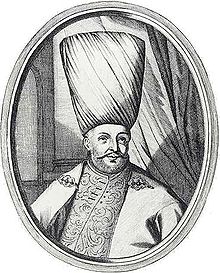Köprülüzade Fazıl Ahmed Pasha
Köprülü Fazıl Ahmed | |
|---|---|
 An engraving | |
| Grand Vizier of the Ottoman Empire | |
| In office 31 October 1661 – 3 November 1676 | |
| Monarch | Murat IV |
| Preceded by | Köprülü Mehmed Pasha |
| Succeeded by | Kara Mustafa Pasha |
| Personal details | |
| Born | 1635 Veles (then named Köprülü, now in Macedonia) |
| Died | 3 November 1676 Constantinople, Ottoman Empire |
| Nationality | Ottoman |
| Relations | Köprülü Mehmed Pasha (father) Köprülü Fazıl Mustafa Pasha (brother) |
| Origins | Albanian |
| Family | Köprülü family |
| Military service | |
| Allegiance | |
| Battles/wars | Austro-Turkish War (1663–64) Polish–Ottoman War (1672–76) |
Köprülü Fazıl Ahmed Pasha (Template:Lang-sq; 1635 – 3 November 1676) was a member of the renowned Köprülü family originating from Albania, which produced six grand viziers of the Ottoman Empire.[1]

Life
He served as a grand vizier from 1661 to 1676 after he inherited the title from his father, Köprülü Mehmed Pasha, the founder of the Köprülü political family. Prior to this appointment, he served as the Ottoman governor of the Damascus Eyalet (1660 to 1661) and the Erzurum Eyalet (1659 to 1660).[2]
He was dubbed Fazıl, meaning "wise" (from the Arabic fazilet, meaning "wisdom"), for reducing taxation and promoting education. On the other hand, he was brutal in war. He led the Ottoman army in the Austro-Turkish War (1663-1664). At the beginning of July 1664, he succeeded in destroying Novi Zrin Castle in northern Croatia after nearly a month-long siege. Although defeated in the Battle of Saint Gotthard, he was able to gain territory by the Treaty of Vasvar in 1664. Following this treaty, he concentrated on the Cretan War and captured Candia (present day Heraklion) from the Republic of Venice in 1669. At the end of the war against the Polish-Lithuanian Commonwealth, he signed the Treaty of Buchach in 1672 and the Treaty of Zurawno in 1676.
See also
- Köprülü family
- Köprülü era of the Ottoman Empire
- List of Ottoman Grand Viziers
- List of Ottoman governors of Damascus
References
- ^ Encyclopedia of the Ottoman Empire By Gábor Ágoston, Bruce Alan Masters, [1]
- ^ Mehmet Süreyya (1996) [1890], Nuri Akbayar; Seyit A. Kahraman (eds.), Sicill-i Osmanî (in Turkish), vol. 1, Beşiktaş, Istanbul: Türkiye Kültür Bakanlığı and Türkiye Ekonomik ve Toplumsal Tarih Vakfı, p. 209
External links
- . Encyclopædia Britannica (11th ed.). 1911.

